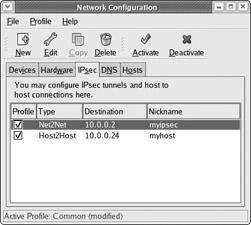Configuring IPsec with redhat-config-network
|
| < Day Day Up > |
|
The redhat-config-network tool now provides the support for implementing IPsec connections. On the redhat-config-networkwork tool, select the IPsec panel (see Figure 17-1) and click New to start the IPsec settings wizard for creating an IPsec connection. You are first asked to enter a nickname for the connection and to specify if you want it started automatically. You then choose the connection type. This can be either a direct host-to-host connection or a connection between two networks. A network connection implements a virtual private network (VPN) and runs IPsec in tunnel mode. (Both the host and VPN connections are described in detail in the following sections.) You then select the kind of encryption you want to use. This can either be manual or use IKE, letting racoon automatically manage the encryption and authentication process.

Figure 17-1: IPsec on redhatconfig- network
You then will configure both your local and remote connections, starting with the local settings. For a host-to-host connection, you need only enter the IP address for the remote host. For a VPN, you will have to enter corresponding addresses for the local and remote networks. For the local network, you will need to enter the IP addresses for the local network, the local network's gateway computer, and the local network's netmask. For the remote VPN connection, you will need the remote IP address, the remote network's address, its netmask, and its gateway address. Finally, you enter the authentication key. Click the Generate button to create one.
A final screen will display your entries. Click Apply to save them. Your connection will appear in the IPsec panel, showing its type, destination, and nickname. To establish a connection, select the IPsec connection and click Activate. This will run the ifup-ipsec script in the /etc/sysconfig/network-scripts directory, which will execute IPsec tools such as setkey and racoon to establish your connection. Configuration data will be kept in the /etc/sysconfig/ networking/devices directory, using the name of the IPsec connections. For example, configuration information on the myipsec IPsec connection is kept in the ifcfg-myipsec file. Corresponding keys for each connection are kept in the keys files, including keys-myipsec. A sample configuration for a VPN is shown here. The IKE method is a private shared key (PSK). The destination (remote) gateway is 10.0.0.1, and the source (local) gateway is 192.168.0.1. The destination (remote) network address is 10.0.0.0/24, and the source (local) address is 192.168.0.0/24. The destination host is 10.0.0.2.
ONBOOT=no IKE_METHOD=PSK DSTGW=10.0.0.1 SRCGW=192.168.0.1 DSTNET=10.0.0.0/24 SRCNET=192.168.0.0/24 DST=10.0.0.2 TYPE=IPSEC
|
| < Day Day Up > |
|
EAN: 2147483647
Pages: 328